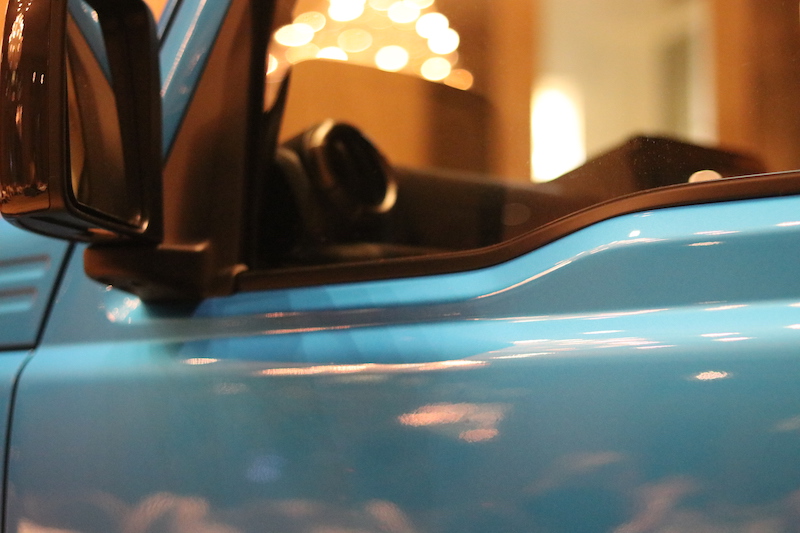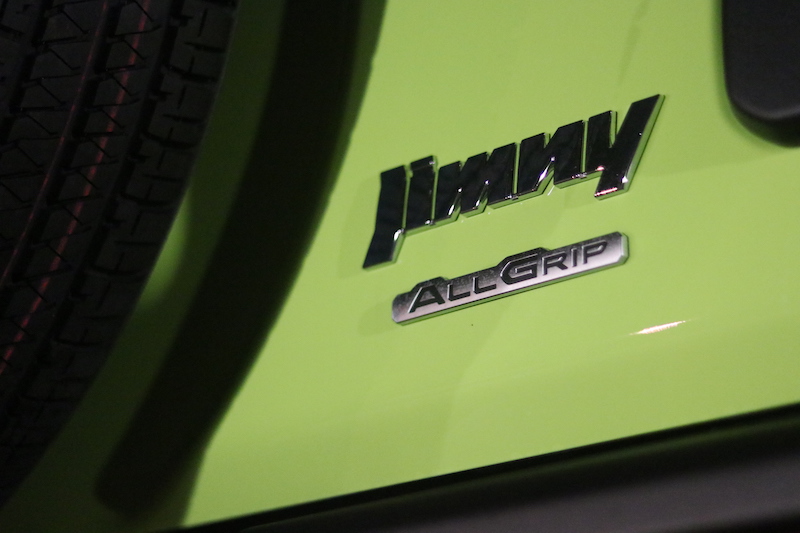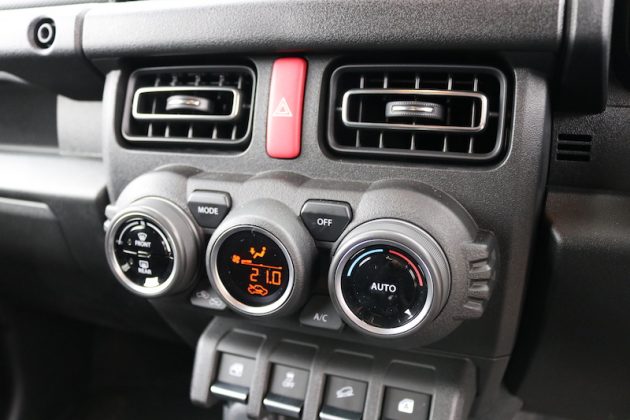Despite being in production since 1970, the Suzuki Jimny has only reached its fourth generation, thanks to the third generation that spanned a production of almost 20 years. Yes, you heard me right, 20! Anyhoo, that was then and this now, the Jimny Mk4, a car that offers a new engine, more technology and a funky new look, but has is it worth the wait?

Are you sure it’s a new car?
The new Jimny has a retro style inspired by design language used in previous versions and it’s all the better for it. It also looks like the result of an orgy between an old Toyota Land Cruiser, a Land Rover Defender and a Mercedes G Wagon, but that’s not a bad thing. The new model is 30mm shorter (in terms of length) than before, but it’s wider and taller. Overall, it’s a cracking looking car that looks to be a fresh of breath of air in the car market, especially if you go for the ‘look at me’ Kinetic Yellow paintwork.
Talking of a breath of fresh air…
The new Jimny has been given a new heart; the 1.3 litre N/A petrol engine has been binned, and in its place is a 1.5 litre N/A petrol unit. If you’re expecting a Boosterjet engine, you’ll be disappointed, as Suzuki currently has no plans to slot one in to a Jimny, This is because the brand feels a naturally aspirated engine is better suited for driving off-road as opposed to a turbo unit.

The new 1.5 engine offers more power than before, but thanks to a 15% lighter weight, it’s more efficient. 101hp is produced by this plucky engine, along with 130Nm of torque. This power is of course mated to all four wheels via a 5-speed manual gearbox and Suzuki’s All Grip Pro. A 4-speed auto is available, but only on the ranging topping model.
As you would expect, performance is far from athletic, but then again, it doesn’t really need to be for its purpose. 0-62 will come in around 13 seconds and the top speed is just 90mph. In regards to running costs, the Jimny is able to offer 35.8 mpg (WLTP) and it emits 178g/km (WLTP), meaning for the first year of VED you’ll be required to pay £515.

What’s it like to drive?
I was lucky enough to experience the car both on road and off it, but let me start with the on road performance. The previous Jimny quickly felt out of place on tarmac thanks to a bouncy, wallowy ride that gave you some idea what it would be like to drive a tractor. It’s handling was far from great and it’s still the supplier for one of my most terrifying driving experiences; driving it on very windy day on the QEII Bridge.

The new model has had its suspension to perform better off road, but also on it, and the difference is most definitely noticeable. It’s still not perfect, but it’s definitely more compliant, and it feels more like a normal road car. The handling is still a bit rolly-polly, but at least it doesn’t lean as much as the old car, which felt like it could roll over if pushed too hard.
As you would expect, the engine needs to be worked hard to make any decent progress meaning it can get noisy in the cabin. You can also hear the transmission whir, but I quite like that to be honest. Tyre noise is very good though, but wind noise is predictable given the car’s boxy shape. There’s plenty of large glass surfaces around though, so seeing out is a complete doddle.

Visibility has also been further improved by installing a flat clamshell bonnet, A-pillars that are more upright, and front windows that have a dip in them to help you spot any obstacles that may damage the side. Speaking of handy features, the speedo has been made horizontal to give you a better idea of the car’s angle, and the roof has a special guttering to stop water getting in when you open the door.

The boot is also bigger than before, by 53 litres, in fact. With the rear seats down you’ll now be able to enjoy 377 litres worth of space, plus the rear seats fold flat and the backs are designed to be wiped down. The rear lights have been moved to the rear bumper, meaning the opening for the boot is now wider and more practical.
Yeah, yeah, yeah – what is it like off-road?
There’s a good chance what you really want to know is how the new Jimny goes off road. This is an area where the Jimny has simply excelled in but has the new model got what it takes? In a word, yes. The new model retains the famous ladder frame chassis to make it as robust as possible, but torsional rigidity has been improved, and the axles have also been beefed up.
Following customer feedback, the buttons to change the driving modes has gone, and the old-school lever has come back. The reason why this is preferred is because you get a greater sense of feeling the car transfer in to its low range gearbox. I had a quick spin off-road at Stoneleigh Park and although the car was still running on road tyres, the performance was simply outstanding.

The level of grip was consistent and strong, even when the going got really muddy, leaving you a state of disbelief of this pint-sized SUV can do. The ride is still bumpy, so you will still be thrown around a bit, however, it’s more comfortable than the last model, which could you see almost bang heads with your front passenger if you weren’t careful.

The steering requires a a fair amount of work – this is even more true on road – but that’s because the rack needs to be setup for off-road driving, but it’s light enough not for it to feel like a chore.
The extra visibility pays dividends once you get on the muddy stuff as it you can so much around you, which inspires confidence. Speaking of confidence, the hill descent control works very well. The new Jimny has a higher ground clearance than before, plus the ramp and departure angles have been improved, meaning it’s more versatile off-road.

More advanced than before
The previous Jimny was a bit of a time machine. Why? Well, once you stepped in and saw the interior it was like transported to the past as it was dated and in need to modernisation. Thankfully the new Jimny delivers that, but you still get rugged, durable surfaces that can be wiped down if they get grubby.
However, you now get standard kit such as Bluetooth, DAB radio, and autonomous emergency braking, although if you pay more for the range-topping model you’ll be able to enjoy climate control, heated front seats, LED headlights, navigation, and a 7″ touchscreen that can still be operated with gloves on – very handy.
Two trim levels are on offer for the new Jimny; SZ4 and SZ5. SZ4 starts from £15,499, boasting features such as four wheel drive, autonomous emergency braking, lane departure warning, front foglamps, automatic headlights with high beam assist, cruise control, air conditioning, Bluetooth, DAB radio and 15″ steel wheels.
The SZ5 starts from £17,999 (£18,999 for the auto), adding features such as 15″ alloy wheels, rear privacy glass, LED headlights, climate control, leather covered steering wheel, navigation, smartphone connectivity and heated front seats.
So it’s more advanced – what about safety?
The Jimny may have new safety kit, but unfortunately for Suzuki, Euro NCAP scored it just three stars. One of the biggest pitfalls of the Jimny is its boxy design and the ladder frame chassis, meaning it doesn’t really cope too well when crashed. Because of it’s square, boxy frame, it won’t be particularly kind to pedestrians, although they’ll have no problem seeing you if you go for the Kinetic Yellow paintwork…

Supply and demand
Unfortunately, the Jimny has become a victim of its own success, and the demand for the new one is very high, especially in Japan. Because of this, the UK market will suffer and buyers will have to be patient before their Jimny lands on their drive. At present, around 10,000 people in the UK have registered their interest, which may not sound too bad, but if you consider around 1,100 models will arrive in the UK in 2019.
Therefore, you don’t have to be a mathematician to work out there is going to be a supply issue here. So if you want to get your hands on a Jimny, get to your local Suzuki dealer as soon as possible.

Final thoughts
Is the new Jimny better than the old one? No. It’s much better, and what I like is that Suzuki has taken what worked well on the last model, kept it and improved on it. Yes, it’s still not perfect on road, but it’s much more agreeable than its predecessor and let’s be honest, this car is made for the rough and tumble. Demand vastly outweighs supply though, so there’s a strong chance UK buyers will have a long wait to get one. Is it worth the wait though? In a word, yes.

































